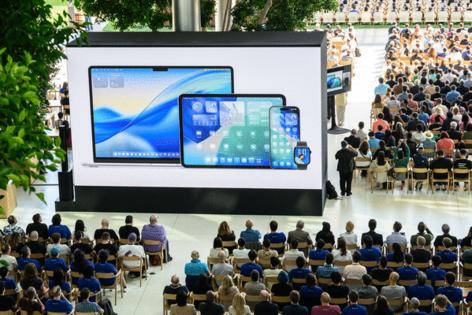Apple debuts Liquid Glass interface at design-focused WWDC event
Published in Business News
Apple Inc. unveiled a new operating system interface called Liquid Glass at its annual Worldwide Developers Conference, an event that focused heavily on aesthetics and design elements rather than software breakthroughs.
For the first time, the same interface will work across the company’s products, executive Alan Dye said Monday during a video presentation from Apple’s headquarters in Cupertino, California. He described it as the company’s broadest design update ever.
Apple also confirmed plans to open up its AI models to outside developers — a move that lets app creators weave the technology into their software.
The artificial intelligence market has been a weak spot for Apple. After unveiling its Apple Intelligence platform at last year’s WWDC, the company was slow to roll out new features — and its technology has paled next to that of Silicon Valley peers. This year’s conference isn’t expected to turn things around, but Apple is planning to showcase bigger AI breakthroughs in 2026, Bloomberg News has reported.
As part of the changes, Apple is renaming its OS lineup to refer to the year rather than version numbers. The next generation of software for the flagship iPhone will be known as iOS 26. The other new releases include watchOS 26, macOS 26 and iPadOS 26.
The event, better known as WWDC, is Apple’s yearly showcase of upcoming software and features. Though the company introduced some new AI capabilities as part of the conference, the focus was more on operating systems changes and design elements — the kind of enhancements that may excite Apple fans but don’t typically impress investors.
Bloomberg News reported on the changes prior to the event, which held few surprises. The Apple shares slid as much as 1.9% during the presentation before beginning to rebound. Already, the stock was down 19% this year through the end of last week, costing the company its crown as the world’s most valuable business.
The company has filled some gaps in its AI lineup by teaming up with OpenAI, maker of ChatGPT. That relationship, first announced last year, will include new image-creation capabilities, Apple said on Monday. The company also highlighted live-translation capabilities and mapping features that learn from users’ routines. And there’s a new dedicated gaming app that ties together features and lets players challenge their friends.
Apple said that its Vision Pro headset will now work with Sony Group Corp.’s PlayStation VR controllers, another attempt to entice more gamers. The product’s software, visionOS, also features more realistic Persona virtual avatars for videoconferencing.
For the Apple Watch, a new Workout app will include an AI-infused “Buddy” feature that helps users stay fit. The MacOS software, meanwhile, has a transparent menu bar with more customizable controls and can now use the iPhone’s Phone app. It will be known as MacOS 26 Tahoe, named for the famous lake that straddles the California-Nevada border.
Apple is improving the multitasking capabilities of the iPad and adding a menu bar to the top, making it more like the Mac. The changes are expected to help users be more productive and turn the iPad into a more effective tool for office work.
Chief Executive Officer Tim Cook said that beta versions of the software will be available to developers immediately. In July, it will go into a public beta — a stage where more users can test out the software — before launching to all consumers in the fall.
The hope is to give customers more reason to upgrade their devices — at a time when prices are likely to rise. Apple has been contending with Trump administration tariffs, prompting it to shift production of U.S.-bound iPhones to India. Even with the changes, the company is increasingly likely to increase prices. Apple typically unveils new devices in September.
©2025 Bloomberg L.P. Visit bloomberg.com. Distributed by Tribune Content Agency, LLC.












Comments